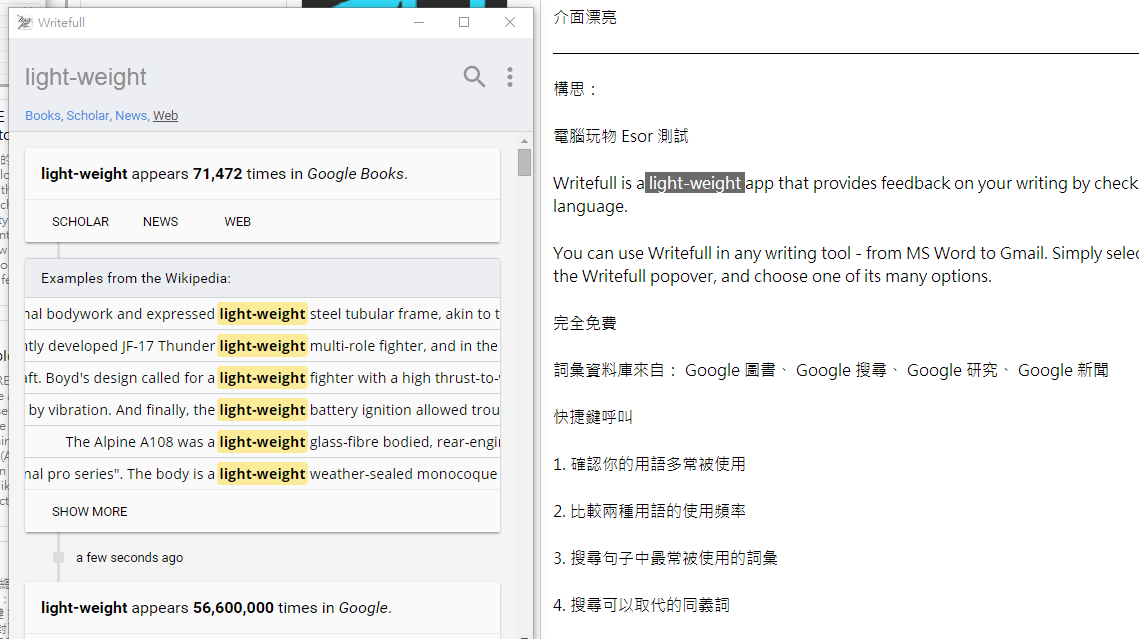

Such replacements work, but only for as long as an author writes exactly what needs to be replaced so that it maps onto the predefined rules. They use predefined rules instead, of the type the researches becomes the research and singular subject + plural verb becomes singular subject + singular verb.

This difference comes from the fact that Writefull is fully AI-based, whereas other tools use little or no AI.
#Writefull tool full#
Writefull’s Full Edit goes far beyond this, fixing and rewriting even the longest and most complex sentences. Other tools are often limited to a basic grammar screening and a set of vocabulary checks. The main difference with other language tools is that Full Edit checks and corrects a lot more. How does Full Edit – recently launched by Writefull – go beyond other tools in its language feedback capabilities? For example, given a dataset of physics papers, we could make the models also pick up on inconsistencies or deviations within physics-specific sentences, such as around formulas. We’ve built the algorithms in such a way that they’re flexible, and we can fine-tune them to new data with little effort. Writefull offers language feedback catered specifically to the academic community. For example, it does not flag disciplinary vocabulary as misspellings as the models have seen these words in training, and it keeps functioning when sentences get complex thanks to the training data consisting mostly of complex sentences. But you also notice it in other, more implicit ways. You notice this in the sense that its suggestions make a text sound more scientific – for example, it might suggest to replace ‘a couple of’ with ‘several’ or ‘big’ with ‘key’. Thanks to this focused dataset, the models now give language feedback that is appropriate to scientific writing. In Writefull’s case, we trained the algorithms on scientific and technical content only the training data consists of peer-reviewed Open Access articles. The output of any AI-driven model depends on the data it’s been trained on. Could you tell us more about these advanced algorithms? Writefull uses Artificial Intelligence and Deep Learning processes to ensure its algorithms provide a thorough language editing software. Parsing and cleaning the data, then training, testing, and retraining the models – the first ‘new’ version took months to develop, and the first years of it were mostly about manually checking the models’ results, tracking the errors, and tweaking and retraining the models. The development of this new version required a lot of technical and linguistic expertise. This is where we moved to the current, AI-based version of Writefull. But we also realised that, to fully support authors, it would be best if Writefull would automatically proofread their texts. Writefull’s Full Edit fixes and rewrites even the longest and most complex sentences. Our PhDs were in Computer Science (Artificial Intelligence) and Applied Linguistics, and we just enjoyed combining our field knowledge to develop an app – it was a welcome break from academia, too. At the time, this was more of a fun side-project than anything else. As we found out that many of our peers did the same, we decided to develop an app that would directly fetch this information from Google Scholar. Being junior researchers and non-native English speakers, we would often resort to Google while writing: we would search for a word or phrase, and use the number of results and the snippets as a sanity check. Two of our team members developed the first version of Writefull around ten years ago, during our PhDs. Dr Hilde van Zeeland.Ĭould you tell us about the history of Writefull, and about the expertise that went into its creation? This fully AI-based feedback mode is capable of rigorous and thorough editing, ensuring all papers – regardless of the author’s native tongue or language proficiency – reach the highest level of technical specificity and style.
#Writefull tool software#
Writefull has recently taken its software to a higher level, with the launch of Full Edit. This focus does not limit its application across disciplines, however, as the software is regularly tested on papers covering a vast array of topics. Writefull is unique in that its algorithms are trained by and focused upon technical scientific content, meaning its proofreading is tailored specifically to scientists and academics. We also spoke broadly about natural language processing (NLP) and Deep Learning algorithms as they pertain to academic publishing. Research Outreach caught up with Dr Hilde van Zeeland, Applied Linguist at Writefull, to learn more about how these algorithms work. Using highly complex algorithms, it offers a full array of language feedback – covering everything from wording, syntax, and grammar – catered specifically to the academic community. Writefull provides advanced academic and technical writing software that goes well beyond the tools provided by other grammar checkers.


 0 kommentar(er)
0 kommentar(er)
